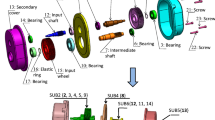Abstract
In this paper, a new model for estimating disassembly effort during early stages of product design is proposed. The model has been developed by integrating two well-known models in the field of product disassembly: Das et al. Disassembly Effort Index (DEI) model and Kroll and Hanft Disassembly Evaluation model. The first one is a multi-factor cost and effort model, which is widely used for determining disassembly effort in terms of a DEI score. This score is a representative of the total operating cost incurred in disassembling a product. The second model is commonly used for evaluating ease of disassembly, by assigning task difficulty scores to disassembly tasks. Data necessary for determining these scores are obtained from work-measurement analyses of standard disassembly tasks. The proposed model has been demonstrated by an estimation of disassembly effort for a CRT monitor disassembly process using the model and validated by benchmarking the results obtained using the proposed model against results from an existing model for a case study conducted on fifteen computer electronic products.



Similar content being viewed by others
References
Appelqvist P, Lehtonen JM, Kokkonen J (2004) Modeling in product and supply chain design: literature survey and case study. J Manuf Technol Manag 15(7):675–685
Berliner C, Brimson JA (1988) Cost management for today’s advanced manufacturing: the CAM-I conceptual design. Harvard Business School Press, Computer integrated manufacturing systems
Brennan L, Gupta SM, Taleb KN (1994) Operations planning issues in an assembly/disassembly environment. Int J Oper Prod Manag 14(9):57–67
Campbell MI, Hasan A (2003) Design evaluation method for the disassembly of electronic equipment, International Conference on Engineering Design, Stockholm
Carter D, Baker B (1992) Concurrent Engineering: the product development environment for the 1990s. Addison-Wesley Publishing Company, Massa-chussets
Chen KZ (2001) Development of integrated design for disassembly and recycling in concurrent engineering. Integr Manuf Syst 12:67–79
Chiu M-C, Kremer GEO (2011) Investigation of the applicability of Design for X tools during design concept evolution: a literature review. Int. J. Product Development 13(2):132–167
Das SK, Yedlarajiah P, Narendra R (2000) An approach for estimating the end-of-life product disassembly effort and cost. Int J Prod Res 38(3):657–673
Desai A, Mital A (2003) Evaluation of disassemblability to enable design for disassembly in mass production. Int J Ind Ergon 32:265–281
Dowlatshahi S (1996) Role of logistics in concurrent engineering. Int J Prod Econ 44(3):189–199
‘E-waste: dismantling a CRT monitor’, uploaded by ewasteguide [online] http://www.youtube.com/watch?v=WHC35ucKK-E Accessed 13 March 2009
Fabrycky WJ, Blanchard BS (1991) Life-Cycle cost and economics analysis. Prentice-Hall, New Jersey
Feldmann K, Trautner S, Meedt O (1999) Design for disassembly: a critical twenty-first century discipline. Annu Rev Control 23:159–164
Giudice F, Kassem M (2009) End-of-life impact reduction through analysis and redistribution of disassembly depth: a case study in electronic device redesign. Comput Ind Eng 57:677–690
Go TF, Wahab DA, Rahman MN Ab, Ramli R, Azhari CH (2011) Disassemblability of end-of life vehicle: a critical review of evaluation methods. J Clean Prod 19:1536–1546
Gungor A (2006) Evaluation of connection types in design for disassembly (DFD) using analytic network process. Comput Ind Eng 50:35–54
Gungor A, Gupta SM (1997) An evaluation methodology for disassembly processes. Comput Ind Eng 33(1–2):329–332
Harivardhini S, Chakrabarti A (2014) Analysis of dismantling processes for assessing disassembly effort and ergonomic hazards at the end of life of electronic appliances. ARPN J Eng Appl Sci 9(3):204–214
Harivardhini S, Chakrabarti A (2015) Comparison of disassembly effort and ergonomic hazards in dismantling electronic appliances by formal and informal recycling sectors in develo** countries. Int J Prod Lifecycle Manag 8(2):111–131
Harjula T, Rapoza B, Knight WA, Boothroyd G (1996) Design for disassembly and the environment. Ann ClRP 45(7):109–114
Keys LK (1990) System life cycle engineering and DF‘X’. IEEE Trans Compon Hybrids Manuf Technol 13(1):83–93
Kroll E, Hanft TA (1998) Quantitative evaluation of product disassembly for recycling. Res Eng Design 10:101–114
Mok HS, Kim HJ, Moon KS (1997) Disassemblability of mechanical parts in automobile for recycling. Comput Ind Eng 33(3–4):621–624
Santochi M, Dini G, Failli F (2002) Computer aided disassembly planning: state of the art and perspectives. CIRP Ann Manuf Technol 51(2):507–529
Sodhi M, Knight WA (1998) Product design for disassembly and bulk recycling. Ann CIRP 47(1):115–118
Sodhi R, Sonnenberg M, Das S (2004) Evaluating the unfastening effort in design for disassembly and serviceability. J Eng Des 15(1):69–90
Spearman’s Rank correlation coefficient—Excel guide, Royal Geographical Society with IBG, www.rgs.org
Subramani A, Dewhurst P (1994) Repair time estimation for early stages of product development. J Des Manuf 4(2):129–137
Suga T, Saneshige K, Fiujimoto J (1996) Quantitative disassembly evaluation. Proceedings of the 1996 IEEE international symposium on electronics and the environment, pp 19–24
Veerakamolmal P, Gupta SM (1999) A Combinatorial cost-benefit analysis methodology for designing modular electronic products for the environment. Proceedings of the 1999 IEEE international symposium on electronics and the environment, pp 268–273
Vinodh S, Nachiappan N, Praveen Kumar R (2011) Sustainability through disassembly modeling, planning, and leveling: a case study. Clean Technol Environ Policy. doi:10.1007/s10098-011-0361-5
Viswanathan S, Allada V (2001) Configuration analysis to support product redesign for end-of-life disassembly. Int J Prod Res 39(8):1733–1753
Wang JP, Allada V (2000) Hierarchial fuzzy neural network based serviceability evaluation. Int J Agile Manag Syst 2(2):130–141
Yi HC, Park YC, Lee KS (2003) A study on the method of disassembly time evaluation of a product using work factor method. Proceedings of the 2003 IEEE international conference on systems, Man Cybernetics, pp 1753–1759
Author information
Authors and Affiliations
Corresponding author
Rights and permissions
About this article
Cite this article
Harivardhini, S., Chakrabarti, A. A new model for estimating End-of-Life disassembly effort during early stages of product design. Clean Techn Environ Policy 18, 1585–1598 (2016). https://doi.org/10.1007/s10098-016-1142-y
Received:
Accepted:
Published:
Issue Date:
DOI: https://doi.org/10.1007/s10098-016-1142-y




